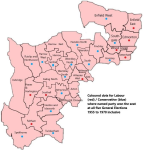Mosaic Reform Synagogue
1959 establishments in England20th-century synagoguesBuildings and structures in the London Borough of HarrowEngvarB from February 2016Jewish organizations established in 1959 ... and 3 more
Reform synagogues in the United KingdomReligion in the London Borough of HarrowSynagogues in London
Mosaic Reform Synagogue is a synagogue in Harrow, London, England. A member of the Movement for Reform Judaism, its rabbi is Kathleen de Magtige-Middleton. The community was established as Middlesex New Synagogue in 1959 and has been based at its current location, 9 Bessborough Road, Harrow HA1 3BS, since 1962. Its current building, which was dedicated in 1977, is now shared with two other congregations – Mosaic Liberal (formerly Harrow & Wembley Progressive Synagogue) and Mosaic Masorti (Hatch End Masorti Synagogue).
Excerpt from the Wikipedia article Mosaic Reform Synagogue (License: CC BY-SA 3.0, Authors).Mosaic Reform Synagogue
Bessborough Road, London Harrow on the Hill (London Borough of Harrow)
Geographical coordinates (GPS) Address Phone number Website External links Nearby Places Show on map
Geographical coordinates (GPS)
| Latitude | Longitude |
|---|---|
| N 51.5785 ° | E -0.3421 ° |
Address
Mosaic Reform Synagogue
Bessborough Road 39
HA1 3BS London, Harrow on the Hill (London Borough of Harrow)
England, United Kingdom
Open on Google Maps









